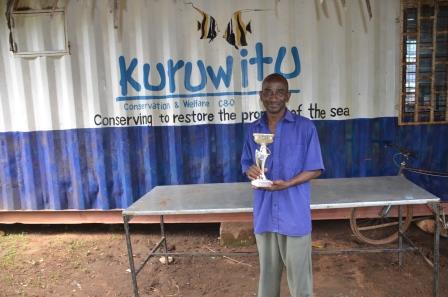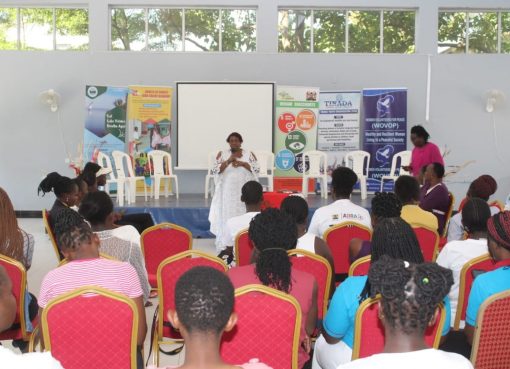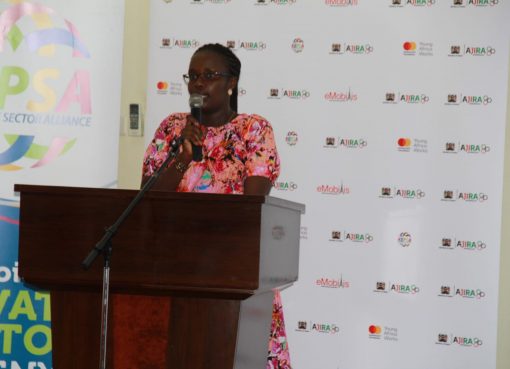The call came on a late afternoon of November 2002. Mzee Dickson Juma Gereza, a veteran fisherman at Kuruwitu village 20-km North of Mombasa city along the Kenyan Coast, was to deliver seven kilograms of fish to a client hosting a party for a group of visiting tourists.
He took his fishing spear and a basket and went off to the community’s traditional fishing grounds. The afternoon fishing expedition turned out to be a disaster. Hours of diving into the deep ocean waters searching for fish yielded the smallest catch in his life as a fisherman.

“I barely managed to get fish catch weighing three kilograms. My client accused me of ruining his party,” recalls Mzee Gereza.
He was not alone. Over the years, dozens of fishermen in Kuruwitu village had detected a drastic decline in their daily catch. The reduction in fish population posed unprecedented crisis to this fishing community where almost everyone relies on fishing as the main source of livelihood.
Several crisis meetings were held to tackle this problem that threatened their very lives.
The climax was formation of Kuruwitu Conservation and Welfare Association (KCWA) in 2005. KCWA, a community group with a membership of over 200, would spearhead all activities towards the protection of the ocean along the beach and preservation of marine life.
It banned fishing within 30 hectares of marine zone marked by a reef that separated the shallow waters and the deep ocean. The group also outlawed harvesting of ornamental corals. Members of KCWA were to police the beach and ensure the laws were enforced.
Almost fifteen years after formation of KCWA, Kuruwitu Beach, located 20-km North of Mombasa City in Kenya, has become a model of how communities living along endangered marine zones can be involved in protection and conservation of marine environment and in return reap the benefits of blue economy.
Mzee Gereza, who is also the project manager, terms the project as a phenomenal success. Data by World Conservation Society shows fish population in the Marine Protected Area is booming with fish biomass estimated to grow by a whopping 400 per cent.
The spillover effect of the fish boom at Kuruwitu area is being felt in adjacent fishing grounds managed by other Beach Management Units (BMU) where fishermen are reporting increased catch.
The fields of sea grass used by fish to lay their eggs are regenerating while the endangered green turtles have returned to nest in the sandy beaches as they used to decades ago.
“We learnt our lessons. Now we take personal responsibility and take care of our beach because it sustains us,” he said.
These community efforts have seen Kuruwitu become the first community-owned Marine Park in Kenya.
Mr. Katana Ngara, a member, says the association is committed to ensuring the ocean life is protected in all the six fish landing sites that fall under the association. The sites include Bureni, Kinuni, Vipingo, Mwanamia, Kijangwani and Kuruwitu.
Different fish species have flooded the rehabilitated zones. They include parrot fish, sturgeons, rabbit fish, coral snappers, emperor fish, Porcupine and box fish. The community is also engaged in marine tourism for domestic and foreign tourists, dhow rides, dolphin and whale watching, snorkeling and diving in coral reefs.
The benefits have flowed in. KCWA has been invited to international conferences including World Conservation Congress in South Korea and Madagascar. In 2017, KCWA received the prestigious international Equator Prize for their conservation efforts.
To date, 26 other conservation groups of communities neighboring the ocean have visited Kuruwitu to study this model of community-based marine conservation. The groups are expected to replicate the model in their fishing areas.

Kuruwitu Conservation and Welfare Association (KCWA) project manager Dickson Gereza points at a reef line in the ocean at Kuruwitu beach in Mombasa County along the Indian Ocean.
While some of them are local, others come from as far as Lamu, while others come from Tanzania, Djibouti and Mozambique.
“They want to know how they can adopt what we are doing here to benefit themselves,” he said.
Arthur Tudo, Kenya Wildlife Service (KWS) Assistant Director for Marine Protected Area, says community involvement in marine conservation had multiple benefits. Apart from ensuring regeneration of ocean life in degraded areas, he also says such activities empower the local communities including keeping the beaches clean and attractive.
“They are primarily the users of this marine resource. Taking care of it means it will take care of them,” he says.
The KCWA is supported by Ocean Adventures, a Coast-based organization focusing on conservation of diversity at the Kenyan Coast. Mr. Des Bowden, an official with Ocean Adventure, says the group has introduced growing of coral nurseries to replanting in zones where coral degradation was reported. He adds that fishing in areas with coral is very controlled to avoid destroying the corals.
He also discloses that the community members also fiercely protect their hunting grounds from illegal trawlers and fishermen from other areas who are attracted to the landing sites by the overabundance of fish in the areas.
“They monitor the waters and chase off boats and trawlers that come into this area,” he said. He adds that during the regular clean-up of the beach, the ocean debris washed ashore is recycled into useful products.
KWCA’s approach to environmental protection model is also seen as a solution that can boost food security and create employment for hundreds of locals. He proposes that the government should adopt such models to boost food security for thousands of people living in areas bordering oceans.
Mzee Gereza notes that since KCWA was formed, there is adequate fish for domestic consumption. The fishermen are also getting enough catch to sell.
“We are better off than we were but we expect to be better. If we conserve our marine environment, we will never go hungry,” he says.
KCWA is also viewed as an example of how the blue economy model works. In 2018, Kenya hosted the first ever blue economy conference where sustainable utilization of oceans and other marine bodies was touted as an economic empowerment route.
Amongst other topics, the conference explored ways in which local communities bordering marine zones can be empowered to exploit oceanic resources sustainably. Such ways include controlled fishing, to avoiding overexploitation and public awareness on fishing communities on how to conserve their environment.
By Wagema Mwangi





